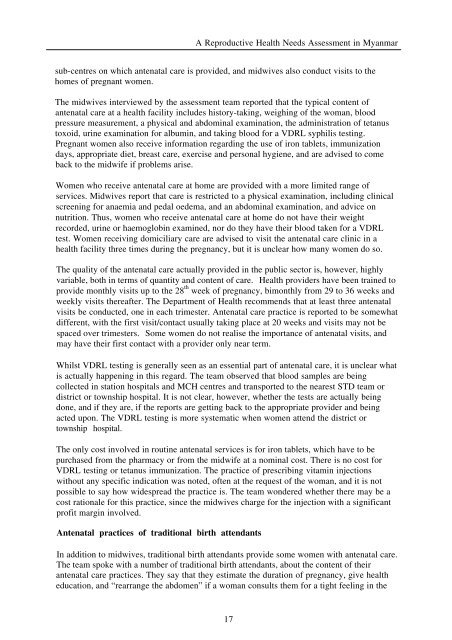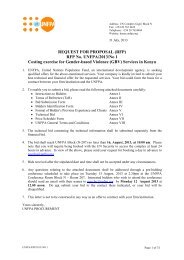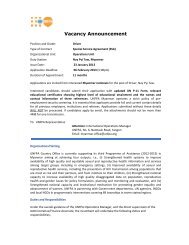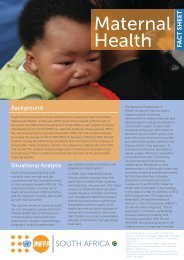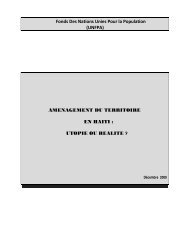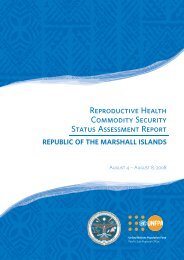A reproductive health needs assessment in Myanmar
A reproductive health needs assessment in Myanmar
A reproductive health needs assessment in Myanmar
You also want an ePaper? Increase the reach of your titles
YUMPU automatically turns print PDFs into web optimized ePapers that Google loves.
A Reproductive Health Needs Assessment <strong>in</strong> <strong>Myanmar</strong><br />
sub-centres on which antenatal care is provided, and midwives also conduct visits to the<br />
homes of pregnant women.<br />
The midwives <strong>in</strong>terviewed by the <strong>assessment</strong> team reported that the typical content of<br />
antenatal care at a <strong>health</strong> facility <strong>in</strong>cludes history-tak<strong>in</strong>g, weigh<strong>in</strong>g of the woman, blood<br />
pressure measurement, a physical and abdom<strong>in</strong>al exam<strong>in</strong>ation, the adm<strong>in</strong>istration of tetanus<br />
toxoid, ur<strong>in</strong>e exam<strong>in</strong>ation for album<strong>in</strong>, and tak<strong>in</strong>g blood for a VDRL syphilis test<strong>in</strong>g.<br />
Pregnant women also receive <strong>in</strong>formation regard<strong>in</strong>g the use of iron tablets, immunization<br />
days, appropriate diet, breast care, exercise and personal hygiene, and are advised to come<br />
back to the midwife if problems arise.<br />
Women who receive antenatal care at home are provided with a more limited range of<br />
services. Midwives report that care is restricted to a physical exam<strong>in</strong>ation, <strong>in</strong>clud<strong>in</strong>g cl<strong>in</strong>ical<br />
screen<strong>in</strong>g for anaemia and pedal oedema, and an abdom<strong>in</strong>al exam<strong>in</strong>ation, and advice on<br />
nutrition. Thus, women who receive antenatal care at home do not have their weight<br />
recorded, ur<strong>in</strong>e or haemoglob<strong>in</strong> exam<strong>in</strong>ed, nor do they have their blood taken for a VDRL<br />
test. Women receiv<strong>in</strong>g domiciliary care are advised to visit the antenatal care cl<strong>in</strong>ic <strong>in</strong> a<br />
<strong>health</strong> facility three times dur<strong>in</strong>g the pregnancy, but it is unclear how many women do so.<br />
The quality of the antenatal care actually provided <strong>in</strong> the public sector is, however, highly<br />
variable, both <strong>in</strong> terms of quantity and content of care. Health providers have been tra<strong>in</strong>ed to<br />
provide monthly visits up to the 28 th week of pregnancy, bimonthly from 29 to 36 weeks and<br />
weekly visits thereafter. The Department of Health recommends that at least three antenatal<br />
visits be conducted, one <strong>in</strong> each trimester. Antenatal care practice is reported to be somewhat<br />
different, with the first visit/contact usually tak<strong>in</strong>g place at 20 weeks and visits may not be<br />
spaced over trimesters. Some women do not realise the importance of antenatal visits, and<br />
may have their first contact with a provider only near term.<br />
Whilst VDRL test<strong>in</strong>g is generally seen as an essential part of antenatal care, it is unclear what<br />
is actually happen<strong>in</strong>g <strong>in</strong> this regard. The team observed that blood samples are be<strong>in</strong>g<br />
collected <strong>in</strong> station hospitals and MCH centres and transported to the nearest STD team or<br />
district or township hospital. It is not clear, however, whether the tests are actually be<strong>in</strong>g<br />
done, and if they are, if the reports are gett<strong>in</strong>g back to the appropriate provider and be<strong>in</strong>g<br />
acted upon. The VDRL test<strong>in</strong>g is more systematic when women attend the district or<br />
township hospital.<br />
The only cost <strong>in</strong>volved <strong>in</strong> rout<strong>in</strong>e antenatal services is for iron tablets, which have to be<br />
purchased from the pharmacy or from the midwife at a nom<strong>in</strong>al cost. There is no cost for<br />
VDRL test<strong>in</strong>g or tetanus immunization. The practice of prescrib<strong>in</strong>g vitam<strong>in</strong> <strong>in</strong>jections<br />
without any specific <strong>in</strong>dication was noted, often at the request of the woman, and it is not<br />
possible to say how widespread the practice is. The team wondered whether there may be a<br />
cost rationale for this practice, s<strong>in</strong>ce the midwives charge for the <strong>in</strong>jection with a significant<br />
profit marg<strong>in</strong> <strong>in</strong>volved.<br />
Antenatal practices of traditional birth attendants<br />
In addition to midwives, traditional birth attendants provide some women with antenatal care.<br />
The team spoke with a number of traditional birth attendants, about the content of their<br />
antenatal care practices. They say that they estimate the duration of pregnancy, give <strong>health</strong><br />
education, and “rearrange the abdomen” if a woman consults them for a tight feel<strong>in</strong>g <strong>in</strong> the<br />
17


